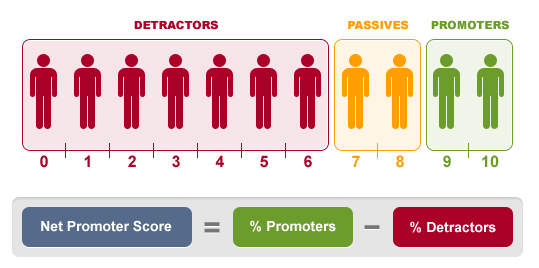What is it?
The Net Promoter Score (NPS) is a customer loyalty rating which is calculated utilising client feedback. The system itself is fairly straightforward as customers are only asked a single question:
How likely is it that you would recommend this company to a friend or colleague?
The question is answered using a scale which ranges from 0 (not likely at all) to 10 (extremely likely). Customers who score in between 0 and 6 are categorised as detractors, those who score 7-8 are categorised as passives and participants who score 9-10 are classed as promoters. The score itself is calculated by taking the percentage of promoters and subtracting the percentage of detractors. Companies should aim to score as high as possible with +100 being perfect, but any positive integer should be taken as a success.
The Benefits
The NPS score is relatively unique in that it provides a clear and informative picture of customer loyalty utilising only a single question. The simplicity of the survey means that customers are much more likely to complete it and you can therefore collect more results and therefore gain a better understanding overall.
Ranking customer loyalty in such a flexible and fluid way allows companies to ascertain how successful their current infrastructure is within the present. This means that any changes in customer relations can be evaluated in real time, by whether your score increases or decreases.
Another benefit of the Net Promoter system is that it provides an opportunity for motivation. Improving your score could be a business wide endeavour, a common goal shared by every employee.
Quality and Quantity
It is worth noting that the survey does not only take into account numerical data but also qualitative information. Once participants have chosen a number from the scale, they are asked to provide further comments on their rating. This allows businesses to gain a unique insight into their ratings and offers ‘best of both worlds’ situation.
This means that companies can look specifically at their lower rated responses and look further into the reasons behind those scores. If the same problems keep cropping up in the comments section they can look at ways to combat these issues from within the business. Alternatively, companies can also look at the higher rated responses and look for patterns within those comments and build upon those successes.
This type of pattern recognition is reminiscent of the techniques utilised within big data and it’s clear that the more responses you collect, the more representative and therefore useful the results will be.
Criticisms
As with all forms of customer satisfaction evaluation, the Net Promoter Score has it criticisms. Some opponents have doubts about the question itself and whether the likelihood of recommending a company is indicative of the company’s overall success. For example, a customer may be completely satisfied with the products and services they receive from a company that sells alcohol but they may be unlikely to recommend the company to friends and colleagues due to the nature of the product. The relationship that the customer has with the company is also going to affect the overall score, for example the likelihood to recommend a personal trainer is likely to change over time and therefore won’t always be indicative of true satisfaction and loyalty.
Another problem that some people have with the system is that it’s too simple and reductionist. Participants could potentially be categorised into 11 different groups but only 3 are used and the passives aren’t factored into the overall score at all.
Overall
It’s clear to see that the Net Promoter Score is a useful tool for measuring customer loyalty, quickly and easily. That being said, this particular measure is biased towards specific types of companies and may be more useful for some than others. In my opinion the NPS is an excellent tool for any business and should be used as a starting point. Whilst some businesses may be fine just utilising this scale, others could benefit from a more comprehensive approach. Use the NPS to highlight specific broad areas of concern and then investigate these issues utilising more in depth methods.


